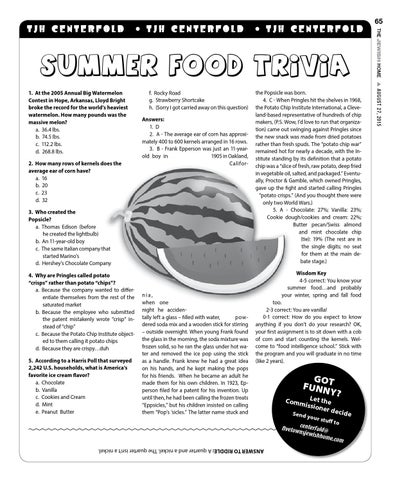• TJH CENTERFOLD
• TJH CENTERFOLD
Summer Food Trivia
THE JEWISH HOME
TJH CENTERFOLD
65 79
2. How many rows of kernels does the average ear of corn have? a. 16 b. 20 c. 23 d. 32
f. Rocky Road g. Strawberry Shortcake h. (Sorry I got carried away on this question) Answers: 1. D 2. A - The average ear of corn has approximately 400 to 600 kernels arranged in 16 rows. 3. B - Frank Epperson was just an 11-yearold boy in 1905 in Oakland, Califor-
3. Who created the Popsicle? a. Thomas Edison (before he created the lightbulb) b. An 11-year-old boy c. The same Italian company that started Marino’s d. Hershey’s Chocolate Company 4. Why are Pringles called potato “crisps” rather than potato “chips”? a. Because the company wanted to differentiate themselves from the rest of the saturated market b. Because the employee who submitted the patent mistakenly wrote “crisp” instead of “chip” c. Because the Potato Chip Institute objected to them calling it potato chips d. Because they are crispy…duh 5. According to a Harris Poll that surveyed 2,242 U.S. households, what is America’s favorite ice cream flavor? a. Chocolate b. Vanilla c. Cookies and Cream d. Mint e. Peanut Butter
nia, when one night he accidentally left a glass – filled with water, powdered soda mix and a wooden stick for stirring – outside overnight. When young Frank found the glass in the morning, the soda mixture was frozen solid, so he ran the glass under hot water and removed the ice pop using the stick as a handle. Frank knew he had a great idea on his hands, and he kept making the pops for his friends. When he became an adult he made them for his own children. In 1923, Epperson filed for a patent for his invention. Up until then, he had been calling the frozen treats “Eppsicles,” but his children insisted on calling them “Pop’s ‘sicles.” The latter name stuck and
the Popsicle was born. 4. C - When Pringles hit the shelves in 1968, the Potato Chip Institute International, a Cleveland-based representative of hundreds of chip makers, (P.S. Wow, I’d love to run that organization) came out swinging against Pringles since the new snack was made from dried potatoes rather than fresh spuds. The “potato chip war” remained hot for nearly a decade, with the Institute standing by its definition that a potato chip was a “slice of fresh, raw potato, deep fried in vegetable oil, salted, and packaged.” Eventually, Proctor & Gamble, which owned Pringles, gave up the fight and started calling Pringles “potato crisps.” (And you thought there were only two World Wars.) 5. A - Chocolate: 27%; Vanilla: 23%; Cookie dough/cookies and cream: 22%; Butter pecan/Swiss almond and mint chocolate chip (tie): 19% (The rest are in the single digits; no seat for them at the main debate stage.) Wisdom Key 4-5 correct: You know your summer food…and probably your winter, spring and fall food too. 2-3 correct: You are vanilla! 0-1 correct: How do you expect to know anything if you don’t do your research? OK, your first assignment is to sit down with a cob of corn and start counting the kernels. Welcome to “food intelligence school.” Stick with the program and you will graduate in no time (like 2 years).
G ot fu n n y?
Comm Let the ission er dec Send
your s t
uff to
ide
fivetow centerfold@ nsjewis hhome. com
AUGUST 27, 2015
1. At the 2005 Annual Big Watermelon Contest in Hope, Arkansas, Lloyd Bright broke the record for the world’s heaviest watermelon. How many pounds was the massive melon? a. 36.4 lbs. b. 74.5 lbs. c. 112.2 lbs. d. 268.8 lbs.
AnSWer to riddLe: A quarter and a nickel. The quarter isn’t a nickel.
